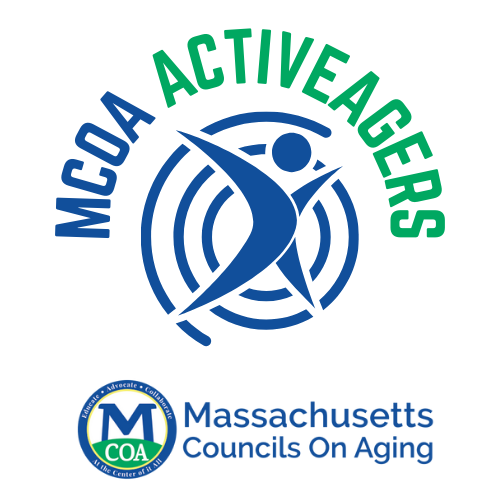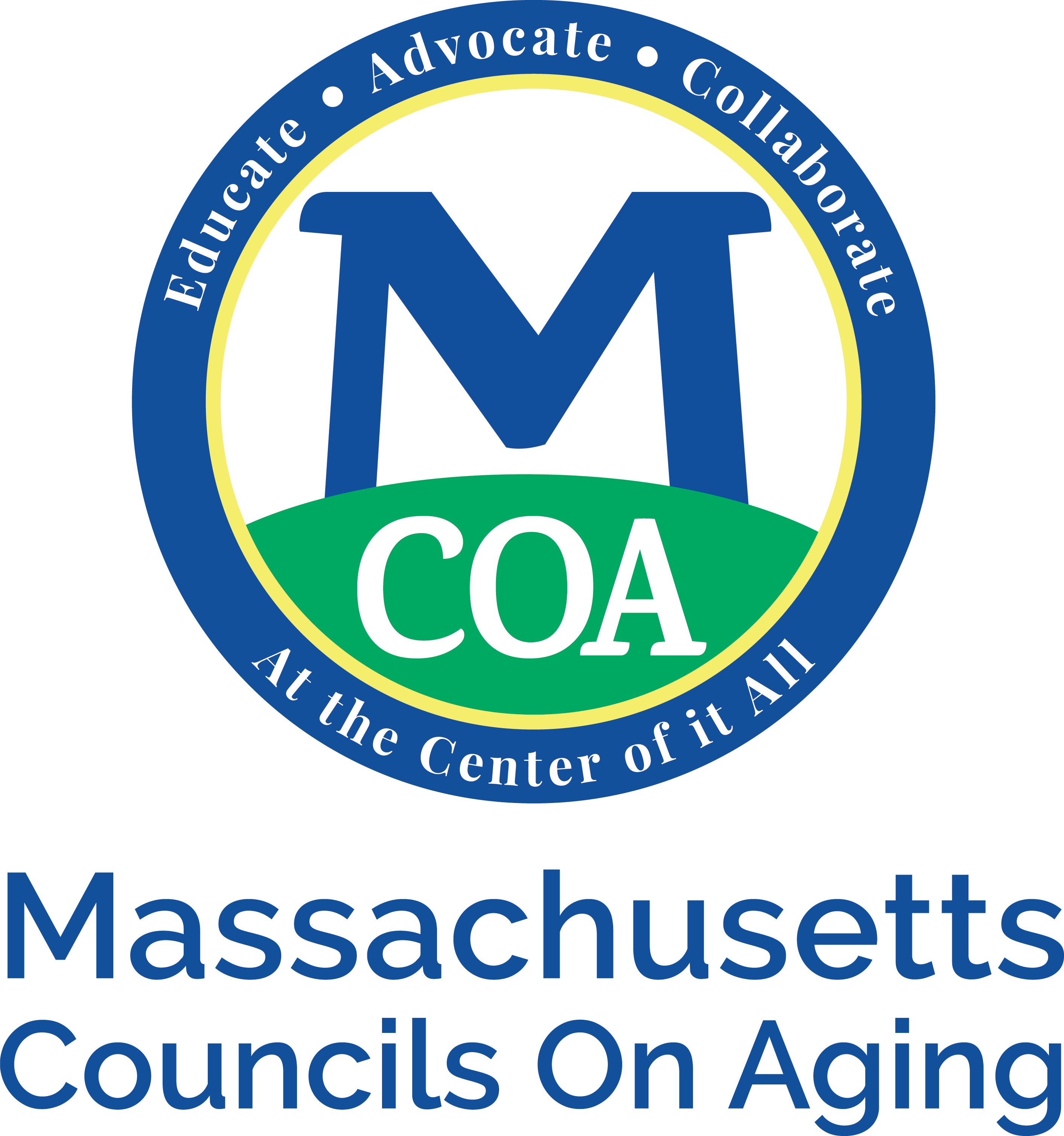Healthy Aging: Nutrition, exercise, stress reduction and sleep
“Our experience is vast, and includes our own body, our mind, our heart and the entire world.”
Jon Kabat-Zinn

Councils on Aging (COAs) are essential in promoting healthy aging by offering diverse programs and services that keep older adults active, eating well, managing chronic conditions, and staying socially connected.
Here’s a look at some key COA programs, supported by MCOA:
- Exercise Classes: COAs provide tailored exercise classes like tai chi, yoga, and strength training, ensuring older adults maintain physical vitality. With MCOA’s technical support, COAs deliver these programs effectively, ensuring participants receive optimal guidance.
- Nutrition Support: COAs offer resources to empower older adults in making healthy dietary choices. With MCOA’s guidance, COAs deliver comprehensive nutrition programs, equipping older adults with the knowledge to nourish body and soul.
- Chronic Disease Management: COAs support older adults in managing conditions like diabetes and heart disease through support groups and education. MCOA enhances these efforts with technical support, training, and innovative programs for better care and support.
- Social Engagement: COAs foster social connections through activities like luncheons and day trips, enriching community engagement. MCOA aids COAs in implementing these programs, enhancing community involvement and a sense of belonging for older adults.
In essence, MCOA supports COAs with technical assistance, training, and innovative programs, ensuring excellence in promoting healthy aging and vibrant communities for older adults in Massachusetts. Together, we strive to ensure every older adult ages with dignity, vitality, and purpose.
- MCOA ActiveAgers Toolkit 2025
- Nutrition Community Checklist Self-Assessment
- MIND diet – Mediterranean-DASH Intervention for Neurodegenerative Delay
- Brain Buddies – MIND diet food groups to consume
- MCOA’s Monthly nutrition newsletter/social media copy
- SNAP Max flier
- Cooking as Self Care handouts and videos
- MyPlate Kitchen is a searchable recipe database. Recipes are often perfect when cooking for one, on a budget or have limited cooking equipment.
- Active People, Healthy Nation strategies to increase physical activity
- How much physical activity do older adults need?
- National Institutes of Health exercise and physical activity fact sheets and tools
- Mastering Your Sleep Hygiene
- Six Dimensions of Wellness & Multicultural Wellness Wheel
- National Councils on Aging Center for Healthy Living
Reports Articles & Data
Average SNAP awards by city/town (age 60, single, living alone) – Oct24 SNAP data
Data bites
last accessed 9/15/23
- Up to 1 out of 2 older adults is either at risk of becoming or is malnourished.
- Disease-associated malnutrition in older adults is estimated to cost $51.3 billion annually
- Protein-calorie malnutrition related hospital stays are 3x more likely to result in death
- Protein-calorie malnutrition related hospital stays are 2x longer
Feeding America: The State of Senior Hunger Report – 2022
last accessed 8/27/24
- 1 in 11 seniors (age 60 and older) was food insecure in 2022. 8.7% of the senior population (6.9 million people) was food insecure. This equals 6.9 million people.
- In Massachusetts, 7.1% of seniors were food insecure.
- Food insecurity among both seniors and older adults (50-50y) remains higher than prior to the Great Recession
- Communities of color experience disproportionate levels of food insecurity, up to four times as high
- Having a disability is strongly associated with food insecurity. Seniors with a disability had food insecurity rates over twice as high as seniors without disabilities (15.3% compared to 6.5%). For older adults, the disparity is even greater. Older adults with disabilities had food insecurity rates more than three times as high as older adults without disabilities (31.2% compared to 9.1%).
Feeding America: Map the Meal Gap
last accessed 8/27/24
- 7.1% of Massachusetts older adults (60y+) are food insecure (n=125,200)
Physical Activity Guidelines for Americans: Older Adults
last accessed 1/25/24
- For substantial health benefits, adults should do at least 150 minutes (2 hours and 30 minutes) to 300 minutes (5 hours) a week of moderate-intensity such as brisk walking
Last accessed 1/25/24
- Falls are the leading cause of injury for adults ages 65 years and older. Over 14 million, or 1 in 4 older adults report falling every year.
- In 2020 in Massachusetts, 26% of older adults reported a fall (n=286,148), and in 2021 over 1,000 died from a fall.
- DGA (Dietary Guidelines for American) provides advice on what to eat and drink to meet nutrient needs, promote health, and prevent disease. Each edition of the Dietary Guidelines reflects the current body of nutrition science. The Dietary Guidelines for Americans are updated every five years. 2020-2025 is the current edition. Chapter six covers older adults.
- MyPlate helps consumers put the Dietary Guidelines for Americans into. Find Spanish versions of many consumer resources at MiPlato en español.
- SNAP (Supplemental Nutrition Assistance Program) is a federal program which provides food benefits to low-income families to supplement their grocery budget so they can afford the nutritious food essential to health and well-being.
- HIP (Healthy Incentives Program) is a federal program that provides a dollar-for-dollar reimbursement when SNAP users buy local produce from farmers.
- CSFP (Commodity Supplemental Food Program) is a federal program providing supplemental food items to people 60 years and older.
- Seniors Nutrition Farmers Market Program (SNFMP) is funded by USDA, administered by Massachusetts Department of Agricultural Resources (DAR), and issued by the Title IIIC programs. It funds farmers’ market coupons books as well as the homebound produce program.
- Home delivered and congregate meals (senior nutrition program)
- Physical Activity Guidelines for Americans: older adults
- National Institutes of Health exercise and physical activity
- National Institutes of Health tools for exercise and physical activity tracking tools
- Centers for Disease Control Active People, Healthy Nation campaign to increase physical activity
- USDA (United States Department of Agriculture) provides leadership on food, agriculture, natural resources, rural development, nutrition, and related issues. USDA’s Food and Nutrition Service (FNS) works to end hunger and obesity through the administration of 15 federal nutrition assistance programs including Supplemental Nutrition Assistance Program, WIC, and school meals.
- DGA (Dietary Guidelines for American) provides advice on what to eat and drink to meet nutrient needs, promote health, and prevent disease. Each edition of the Dietary Guidelines reflects the current body of nutrition science. The Dietary Guidelines for Americans are updated every five years. 2020-2025 is the current edition. Chapter six covers older adults.
- MyPlate helps consumers put the Dietary Guidelines for Americans into. Find Spanish versions of many consumer resources at MiPlato en español.
- SNAP (Supplemental Nutrition Assistance Program) is a federal program which provides food benefits to low-income families to supplement their grocery budget so they can afford the nutritious food essential to health and well-being.
- HIP (Healthy Incentives Program) is a federal program that provides a dollar-for-dollar reimbursement when SNAP users buy local produce from farmers.
- DTA (Department of Transitional Assistance) – assists and empowers low-income individuals and families to meet their basic needs, improve their quality of life, and achieve long term economic self-sufficiency. DTA provides direct economic assistance (cash benefits) and food assistance (SNAP benefits), as well as workforce training opportunities.
- OAA (Older Americans Act) – The Older Americans Act of 1965 was the first federal level initiative aimed at providing comprehensive services for older adults. It created the National Aging Network comprising the Administration on Aging on the federal level, State Units on Aging at the state level, and Area Agencies on Aging at the local level.
- AAA (Area Agency on Aging) implements OAA funding at the local level. Note: Some AAAs are housed within ASAPs.
- Title III – section of the OAA which provides grants for state and community programs on aging. Specifically, Title IIIC is nutrition services. These federal funds flow to the state unit on aging (Massachusetts Executive office of Elder Affairs) then to the Area Agencies on Aging who provide nutrition education, counseling, home-delivered meals (also known as meals on wheels) and congregate meals.
- ASAP (Aging Service Access Point) are private non-profit agencies providing direct and protective services to people aged 60 and older. There are 25 ASAPs statewide.
- Food bank – regional warehouses that procure food to be distributed via food pantries, meal programs, shelters and more. Food banks may also administer additional programs such as mobile pantries, and youth- or older adult-based programs.
- Food pantry – local organization that directly distributes food to people in need.
- CSFP (Commodity Supplemental Food Program) is a federal program providing supplemental food items to people 60 years and older.
- Malnutrition screening is the process of identifying people who may suffer from malnutrition. Questionnaires used are called malnutrition screening tools and are quick and easy-to-use.
- Medical Nutrition Therapy (MNT) is a key component of diabetes education and management. Provided by a registered dietitian nutritionist, it includes a diagnosis and counseling services.
- Sarcopenia is the loss of muscle and strength that can happen when someone gets older and does less physical activity.
- Medically Tailored Meals support people with health conditions requiring specific diets such as heart disease, diabetes, and HIV.
- Food as Medicine (also known as Food is Medicine) is a movement of food-based interventions to help prevent, manage, and treat diet-related diseases to reduce health care services and costs. Intervention examples include produce prescription programs and medically tailored meals.
- Produce Prescription Programs are prescriptions for fruits and vegetables to be used in a health care setting or in the patient’s community. Similarly, fruit and vegetable incentives are coupons or cash incentives consumers can use at the point of purchase.
- Seniors Nutrition Farmers Market Program (SNFMP) is funded by USDA, administered by Massachusetts Department of Agricultural Resources (DAR), and issued by the Title IIIC programs. It funds farmers’ market coupons books as well as the homebound produce program.
- Physical Activity Guidelines for Americans provides evidence-based advice on how physical activity can help promote health and reduce the risk of chronic disease. Chapter five covers older adults.
- The White House Conference on Hunger, Nutrition, and Health was held on September 28, 2022 and catalyzed the public and private sectors around a coordinated strategy to accelerate progress and drive transformative change to end hunger, improve nutrition and physical activity, and close the disparities surrounding them.
- Moderate-intensity aerobic activity is considered a five or six on a ten-point scale where ten is working as hard as you can. It will make you breathe harder and your heart beat faster. You’ll also notice that you’ll be able to talk, but not sing the words to your favorite song.
- Vigorous-intensity aerobic activity is considered a seven or eight on a ten-point scale where ten is working as hard as you can. Your heart rate will increase quite a bit, and you’ll be breathing hard. You won’t be able to say more than a few words without stopping to catch your breath.
Healthy Aging News You Can Use
Cultivating Connection: How Orleans Council on Aging Built a Welcoming Space for LGBTQ+ Older Adults
Cape Cod, especially the Lower Cape region, is home to a significant population of older adults, with nearly 60% of Orleans residents over the age of 60. Within this demographic lies a vibrant, yet sometimes isolated, LGBTQ+ community. Judi Wilson, Director of the...
Bridging Divides: How OutstandingLife is Cultivating Connection and Combating Isolation for LGBTQ+ Older Adults
In Massachusetts, a significant grassroots effort is underway to combat loneliness and isolation among LGBTQ+ older adults. OutstandingLife, Inc., a 501(c)(3) non-profit, has emerged as a vital online community, creating connections and fostering well-being across the...
Building Bridges and Fostering Belonging: Bourne Council on Aging’s Commitment to Inclusivity
The Bourne Council on Aging (COA), led by Director Debora Oliviere, serves residents aged 60 and above, a threshold tied to critical grant funding that supports many of their vital programs. Since assuming the director role in 2020, just weeks before the COVID-19...
